Abstract
The shear characteristics of the frozen soil–concrete interface are core parameters in frost heave resistance design in cold-region engineering, and the influence mechanism of interface roughness on these characteristics is not clear. In this study, the regulatory effect of different roughness levels (R-0 to R-4) on the interfacial freezing strength was quantitatively analyzed for the first time through direct shear tests, and the evolution characteristics of the contribution ratio of the ice cementation strength were revealed. The results show that the peak shear strength of the interface increases significantly with the roughness (when the normal stress is 400 kPa and the water content is 14%, the increase in R-4 is 47.7% compared with R-0); the ice cementation strength increases synchronously and its contribution ratio increases with the increase in roughness. Although the absolute value of the residual strength increase is small, the relative amplitude is larger (178.5% increase under the same working conditions). The peak cohesion increased significantly with the roughness (R-0 to R-4 increased by 268.6%), while the residual cohesion decreased. The peak and residual internal friction angle increased slightly with the roughness. The study clarifies the differential influence mechanism of roughness on the interface’s shear parameters and provides a key quantitative basis for the anti-frost heave design of engineering interfaces in cold regions.
1. Introduction
Permafrost is widely distributed in high-latitude and high-altitude areas, and its unique physical and mechanical properties pose severe challenges to the stability of foundation engineering in cold regions (such as building foundations, bridge pile foundations, oil pipelines, etc.) [1]. Under the influence of freeze–thaw cycles, the degradation of shear strength at the interface between permafrost and structures is one of the key factors inducing frost heave damage in engineering [2]. As a widely used structural material in cold-region engineering, the mechanical behavior of concrete at the interface with permafrost directly affects the frost heave resistance and long-term durability of foundations [3]. In recent years, the development of sustainable concrete technology has provided a new direction for improving the long-term durability and corrosion resistance of reinforced concrete systems in cold regions. For example, advanced technologies such as low-carbon high-performance concrete, nano-modified anti-corrosion materials, and fiber-reinforced composite systems have significantly improved the service performance of underground structures and superstructures in harsh environments by optimizing their microstructure or inhibiting corrosion reactions [4,5]. These materials can reduce the deterioration of the interface caused by freeze–thaw cycles or electrochemical effects in cold-region engineering. However, there is still a lack of research on the shear characteristics of the interface between these materials and frozen soil. In particular, the mechanism through which material properties regulate the mechanical behavior of the interface is still unclear. The discussion of the influence of roughness in this study can provide a basic reference for the application of sustainable concrete in interface engineering in cold regions.
Roughness is one of the important factors affecting interface shear characteristics. Research shows that changes in roughness can significantly affect mechanical parameters such as the interface shear strength and friction coefficient. In the study of soil and structural contact surfaces, a large amount of literature has explored the impact of roughness on interface shear characteristics [6,7,8]. Hu Liming and Pu Jialiu [9] studied the physical and mechanical properties of the contact surface between soil and structure through experiments and found that roughness significantly affects the shear strength of the interface. Wang Yonghong et al. [10] studied the influence of surface roughness on the shear characteristics of the interface between viscous soil and concrete, with the results indicating that increased roughness can enhance the shear strength of the interface. However, there is still a lack of relevant research on the frozen soil–concrete interface. In recent studies, He F et al. [11] found that the mechanism of roughness inhibited the creep of the frozen soil–concrete interface using the creep test. Maria J R et al. [12] proposed a multi-parameter coupling roughness index to achieve the accurate prediction of shear strength. Ruichang F et al. [13] revealed the brittle/strain-softening binary failure mode controlled by roughness. Xuan W et al. [14] confirmed that cyclic loading leads to the attenuation of interface stiffness but does not cause post-cyclic strength degradation.
The shear characteristics of the interface between frozen soil and concrete are not only affected by roughness, but also by the temperature, water content, freezing state and other properties of frozen soil [15,16,17]. Basic research has confirmed the sensitivity of freezing strength to temperature/humidity parameters [18,19], and emerging studies have further revealed its underlying mechanisms. Wan X et al. [20] systematically revealed the formation mechanism of meso-shear bands by conducting direct shear tests on the frozen soil–concrete interface under different ambient temperatures and normal stress conditions, combined with particle flow code (PFC) numerical simulation. Zhang K et al. [21] designed a new temperature-controlled direct shear test system, combined with digital image correlation (DIC) technology and multivariate coupling analysis, and found the strain-softening characteristics dominated by ice cementation. Zhou et al. [22] carried out a vibration shear test and unconfined compression test on the cemented soil–concrete interface and found that the curing time had a strengthening effect on the interface shear strength and the compressive strength of the cemented soil. Wang et al. [23] carried out a freeze–thaw cycle-direct shear coupling test and identified the two-stage damage induced by the freeze–thaw cycle. Zhou Yalong et al. [24] proposed the hyperbolic evolution law of ice film thickness through a negative temperature direct shear test of the frozen sand–concrete interface and the three-fold line model.
Although the existing research focuses on the influence of roughness and normal stress on the shear characteristics of the frozen soil–concrete interface, there are two shortcomings: First, the quantitative evolution law and contribution ratio of the ice cementation strength to roughness are not revealed. Secondly, there is a lack of research on the characteristics of the interface between advanced materials such as sustainable concrete and frozen soil. In this study, the quantitative influence of different roughness grades (R-0 to R-4) on the peak/residual shear strength, ice cementation strength contribution ratio, cohesion and internal friction angle of the interface was revealed by a direct shear test. The research results not only clarify the regulation mechanism of roughness on interface shear characteristics, but also provide key parameters and theoretical references for the anti-frost heave design of traditional and sustainable concrete and the frozen soil interface in cold region engineering.
2. Materials and Methods
The experiment used frozen soil–concrete binary body samples and conducted direct shear tests with different interface roughness levels using the ZJ strain-controlled direct shear apparatus (Nanjing Soil Instrument Factory, Nanjing, China). Using the NSIF Geotechnical Test Control and Data Acquisition & Processing System (2024), the shear stress and shear displacement at the frozen soil–concrete interface were determined at different times to analyze the effects of different normal pressures and interface roughness levels on the frozen strength of the binary body interface.
2.1. Test Materials
The soil samples used in this experiment were taken from the permafrost area of Kekexili on the Qinghai–Tibet Plateau. According to the “Standard for Testing Soil Properties” (GB/T50123-2019) [25], the basic physical properties and grain size distribution of these soil samples were analyzed, and the corresponding data is shown in Table 1 and Table 2. The tested soil samples belong to clay with low plasticity.

Table 1.
Physical properties of soil used for experiment.

Table 2.
Grain size distribution of soil used for experiment.
To prepare high-quality concrete test blocks, it is necessary to carefully consider the parameters of the raw materials. Specifically, cement is the main binding material in concrete, so PO42.5-grade ordinary Portland cement is selected. The aggregate serves as the skeleton of the concrete, providing certain strength and stability; therefore, 1–2 mm gravel and natural river sand are chosen as aggregates. Additionally, since the quality of water directly affects the strength and durability of concrete, pure water is used in the preparation process of concrete test blocks.
2.2. Sample Preparation
The preparation of samples includes the preparation of concrete samples, soil samples, and permafrost–concrete binary samples. The specific production process is as follows:
- (1)
- Preparation of concrete samples: A ring cutter with a diameter of 61.8 mm and a height of 20 mm is used as the mold for the concrete samples. Tape is attached to the bottom of the ring cutter to seal it, preventing the cement slurry from spilling out from the bottom. A layer of Vaseline is evenly applied to the inner wall of the ring cutter to facilitate demolding. Ordinary Portland cement PO42.5 is used, and due to the small size of the samples, 1–2 mm gravel is selected to ensure that the sample size is more than five times the particle size. The ratio of cement, gravel, natural river sand, and water is 1:1.36:1.28:0.5 for making the cement slurry. The cement slurry is evenly filled into the ring cutter, vibrated, and leveled to ensure that the sample thickness matches the height of the ring cutter. In order to investigate the effect of different interface roughness levels on the interaction between frozen soil and concrete, different rough surfaces are created on the concrete interface before the initial setting of the concrete samples. A grid of 3 mm, 6 mm, 9 mm, and 12 mm is pressed onto the top surface of the concrete to create four roughness levels of concrete blocks, namely R-1, R-2, R-3, and R-4, as well as a smooth surface concrete block that serves as the control group R-0. From left to right in Figure 1a, they are R-1, R-2, R-3, and R-4. After the concrete samples have initially set, they are removed from the ring cutter and cured according to standard procedures for 28 days [26]. The surface roughness of five kinds of concrete structures is measured by the sand filling method. The sand filling method involves measuring the volume of grooves in the surface range of concrete structures by using standard sand with particle size < 0.5 mm by the volume conversion method, and the average depth is obtained to measure the surface roughness of concrete. The calculation method is shown in Formula (1).
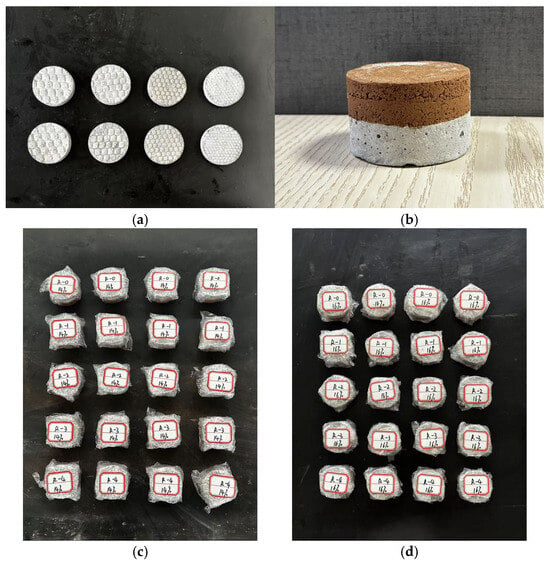 Figure 1. Sample Image: (a) Concrete test blocks of different roughness; (b) Concrete–frozen soil dual test block; (c) Moisture content 14%; (d) Moisture content 16%.
Figure 1. Sample Image: (a) Concrete test blocks of different roughness; (b) Concrete–frozen soil dual test block; (c) Moisture content 14%; (d) Moisture content 16%.
In the formula, R denotes roughness; vs. represents the sand filling volume; and a represents the surface area of the contact surface.
The roughness of R-1, R-2, R-3 and R-4 was 0.73 mm, 0.82 mm, 0.89 mm and 0.96 mm, respectively. It can be seen that the denser the mesh, the greater the roughness.
- (2)
- Soil sample preparation: Dry the undisturbed soil sample in a drying oven at 105 °C for 24 h, crush it through a 2 mm geotechnical standard sieve, and prepare test soil samples with initial moisture contents of 14% and 16%. Use Formulas (2) and (3) to calculate the dry soil mass and the required amount of water to prepare the wet soil sample. Mix thoroughly and then place in a sealed bag to ensure that the dry soil and moisture are fully integrated, ensuring the even distribution of moisture within the soil. After resting for 24 h, re-measure the moisture content, and if qualified, use it as test soil.
In the formula, is the soil quality/kg; is the water quality/kg; is the dry density (g/cm3); is the moisture content (%); and is the initial moisture content (%).
- (3)
- Preparation of frozen soil–concrete composite samples: The frozen soil–concrete composite samples use a ring cutter with a height of 40 mm and a diameter of 61.8 mm as a mold. One end of the ring cutter is pre-sealed with tape, and the rough surface of the concrete block is placed facing up in contact with the soil layer, while the smooth surface is placed down against the tape-sealed layer. The dry density of the soil sample is controlled at 1.7 g/cm3. According to the predetermined water content of the soil sample, a specific mass of soil sample is evenly filled into the ring cutter mold, with the soil sample placed in two layers, each layer 10 mm thick, for compression and tamping. After the first layer is tamped to the desired height, its surface is scraped before adding the next layer. After the preparation of the composite sample is completed, as shown in Figure 1b, the entire sample is wrapped in cling film to prevent moisture loss, as shown in Figure 1c,d, and placed in a −20 °C freezer for 24 h. The main characteristic parameters of the test samples are shown in Table 3.
 Table 3. Main characteristic parameters of samples.
Table 3. Main characteristic parameters of samples.
2.3. Testing Instrument
Using the ZJ strain-controlled direct shear apparatus produced by Nanjing Soil Instrument Factory, as shown in Figure 2, a frozen soil–concrete interface freezing strength test was carried out. The shear box consists of two parts: the upper shear box with a height of 20 mm, which is connected to the load cell, and the lower shear box with a height of 20 mm, which is connected to the loading device. The interface between the upper and lower boxes serves as the shear plane; thus, the frozen soil–concrete test sample’s frozen interface coincides exactly with the shear plane. The loading method for this test is displacement control, and the shear test loading rate is 0.8 mm/min.
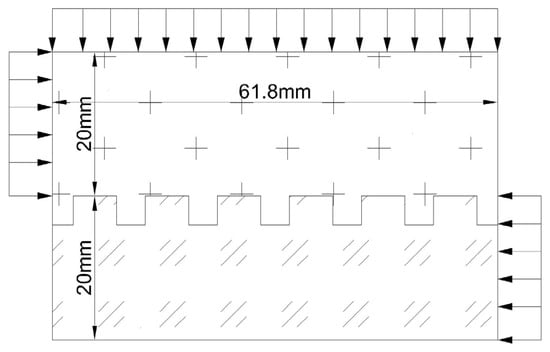
Figure 2.
Loading schematic.
2.4. Testing Process
The experimental process described in this article mainly consists of the following steps: (1) Checking the testing equipment to ensure it is operating normally; (2) Placing the sample into the shear box of the direct shear apparatus, adjusting the loading ring, then applying the lid to impose normal pressure and begin shearing; (3) During the shearing process, recording the shear displacement and shear force, and using software to plot the variation patterns of both for monitoring the experimental process. Figure 2 shows a schematic diagram of the forces acting on the sample during the experiment, where the upper surface of the sample is subjected to a uniformly distributed normal pressure and the upper portion experiences a horizontal thrust, causing the frozen soil section to move to the right, while the right side of the lower portion of the concrete block experiences a horizontal reactive force. As a result, shear deformation occurs at the contact surface, ultimately leading to shear failure. The controlled variables during the experiment include the following: the shear mode is displacement-controlled, the shear rate is set to a rapid shear test of 0.8 mm/min, and the normal stresses are set at 100 kPa, 200 kPa, 300 kPa, and 400 kPa. The setting of the normal stress range refers to the actual engineering scene in the permafrost region of Hoh Xil, Qinghai–Tibet Plateau. During the operation stage of foundation projects in cold regions, such as bridge pile foundations and building foundations in the study area, the normal stress on the frozen soil–concrete interface is usually 100–300 kPa. Considering the influence of extreme working conditions and load combination, the upper limit is extended to 400 kPa to cover the possible stress conditions, which can provide a practical reference for the anti-frost heave design of the project in this area.
3. Results and Analysis
Due to the presence of interfacial bonding ice, the shear stress–shear displacement relationship in frozen soil–concrete interface shear tests is usually of a strain-softening type. The residual stage strength parameters are also crucial for the stability analysis of the interface under large deformations. Therefore, the peak strength characteristics and residual strength characteristics of the interface under different roughness conditions are analyzed, where the maximum value of shear stress is taken as the peak strength, and the shear stress corresponding to a shear displacement of 5 mm is taken as the residual strength.
3.1. Test Shear Stress–Shear Displacement Curve
Figure 3 shows the shear stress–displacement curves for different interface roughness levels. Overall, the shear stress–displacement curves exhibit strain-softening behavior. Once the shear stress reaches the peak shear strength, a significant drop in shear displacement occurs as the shear displacement continues to increase, after which the shear stress–displacement relationship enters the residual stage. In the pre-peak stage, the interface-cemented ice and the cohesion between particles simultaneously bear the shear deformation. As deformation increases, the shear stress rises rapidly, and then some ice crystals fracture, leading to the rolling and sliding of soil particles and ice crystal particles, which causes plastic deformation at the interface until peak stress is reached. Under different experimental conditions, the interface shear stress reaches its peak at a shear displacement of 1–2 mm. During the post-peak softening stage, soil particles and ice crystal particles begin to slide completely, and the interface-cemented ice gradually fractures until complete failure, causing the interface shear stress to also gradually decrease until it stabilizes.
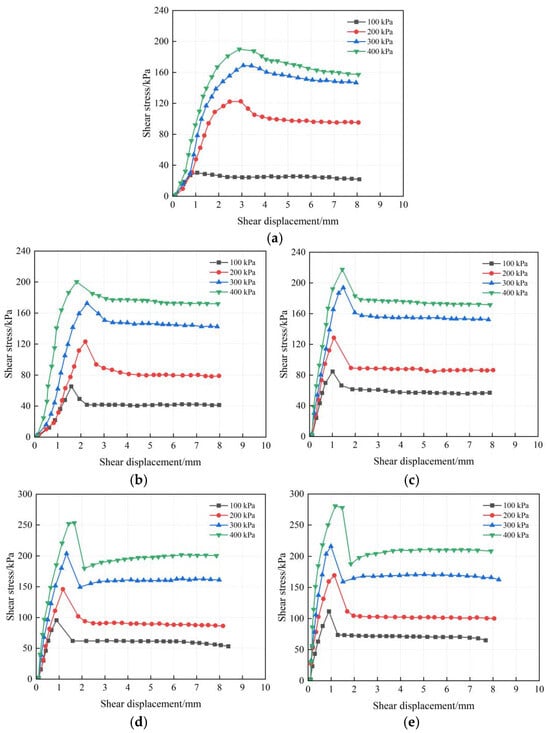
Figure 3.
Interface shear stress and shear displacement curves under different surface roughness and normal stress conditions: (a) R-0; (b) R-1; (c) R-2; (d) R-3; (e) R-4. Note: The initial moisture content of soil samples corresponding to all curves in this diagram is 14%. In this experiment, three parallel tests were carried out in each working condition, and the coefficient of variation of the data was 1.2~3.8%. The repeatability of the test results was good. Each data point is the average value of three parallel tests; the same applies below.
In order to ensure the reliability of the test results, three parallel tests were carried out under all working conditions. The coefficient of variation of the parallel test data was less than 4%, indicating that the test results of the interface shear characteristics were stable and reliable. The rapid post-peak shear stress decrease (Figure 3) directly results from the brittle fracture of interfacial cemented ice, leading to particle sliding during the residual stage. This leads to a noticeable reduction in interface shear stress following the occurrence of brittle failure. As the cemented ice at the interface is completely destroyed and the soil particles and ice crystal particles begin to slide, the interface enters a residual stable stage, and shear stress no longer changes significantly with an increase in shear displacement.
The influence of different roughness interfaces on the shear stress–shear displacement curve is relatively small, but has a significant effect on the peak shear stress and residual shear stress. Comparing the shear stress–shear displacement curves of different interface roughness levels shows that the degree of interface roughness significantly affects the peak shear strength, with the peak shear strength increasing with the increase in interface roughness. With an initial water content of 14% and normal stress of 400 kPa, the peak shear strengths corresponding to interface roughness levels R-0, R-1, R-2, R-3, and R-4 are 190.04 kPa, 200.27 kPa, 217.59 kPa, 253.48 kPa, and 280.64 kPa, respectively.
3.2. Peak Shear Strength Characteristics
Figure 4 shows the curve of the peak shear strength varying with roughness levels. Under two water contents (14% and 16%), the peak shear strength shows a significant upward trend with increasing roughness levels. Figure 4a displays the peak shear strength at an initial water content of 14% under different normal stresses. It can be seen that the peak shear strength significantly increases with the increase in roughness levels. At 100 kPa, the peak shear strength increases from 30.42 kPa at a roughness level of R-0 to 111.46 kPa at R-4; at 400 kPa, it increases from 190.04 kPa at R-0 to 280.64 kPa at R-4. Figure 4b shows the peak shear strength at an initial water content of 16% under different normal stresses. Compared with the peak shear strength at an initial water content of 14%, it is generally higher. At 100 kPa, the peak shear strength increases from 46.45 kPa at R-0 to 130.22 kPa at R-4; at 400 kPa, it increases from 211.61 kPa at R-0 to 296.85 kPa at R-4. In the range of 100~400 kPa normal stress, the increase in the peak shear strength of R-4 (high roughness) (169.18 kPa) is slightly larger than that of R-0 (low roughness, 159.62 kPa). This is because, when the normal stress increases, the concave and convex structure of the highly rough interface (R-4) has a stronger occlusal effect with the frozen soil, and the mechanical embedding force between the soil particles and the concrete surface increases more significantly with the normal pressure. The increase in normal stress promotes an increase in the ice cementation strength, and the ice cementation area of the highly rough interface is larger (the contact between ice and concrete in the groove is more sufficient), so the increase in ice cementation force with normal stress is also higher than that of the smooth interface (R-0). The combined effect of the two causes the peak strength of the high-roughness interface to increase more significantly with the normal stress.
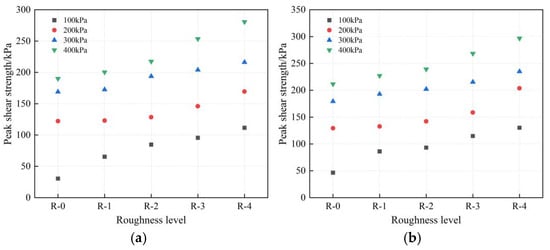
Figure 4.
Curve of peak shear strength variation with roughness grade: (a) Initial moisture content 14%; (b) Initial moisture content 16%. Note: In this experiment, three parallel tests were carried out in each working condition, and the coefficient of variation of the data was 1.2~3.8%. The repeatability of the test results was good.
The shear strength of soil and the shear strength at the interface between the soil and structures depend on many factors, but the Mohr–Coulomb shear strength criterion is the most widely used, as shown in Equation (4). Its strength parameters are cohesion and the internal friction angle. These two parameters can be defined as interface cohesion and the interface friction angle when describing the interface shear strength criterion.
In the formula, is the shear strength, is interface cohesion, is the interface friction angle, and is normal stress.
Figure 5 shows the relationship curve between the interface shear strength and normal stress. Overall, under the same initial water content and interface roughness grade, the peak shear strength of the interface increases linearly with normal stress. Figure 5a illustrates the peak shear strength under different roughness conditions when the initial water content is 14%. It can be seen that the peak shear strength increases with an increase in normal stress. At a roughness grade of R-0, as the normal stress increases from 100 kPa to 400 kPa, the peak shear strength enhances from 30.42 kPa to 190.04 kPa, an increase of 159.62 kPa; at a roughness grade of R-4, as the normal stress increases from 100 kPa to 400 kPa, the peak shear strength enhances from 111.46 kPa to 280.64 kPa, an increase of 169.18 kPa. Figure 5b shows the peak shear strength under different roughness conditions when the initial water content is 16%. Similar to the previous observation, the peak shear strength increases with normal stress. At a roughness grade of R-0, as the normal stress increases from 100 kPa to 400 kPa, the peak shear strength enhances from 46.45 kPa to 211.61 kPa, an increase of 165.16 kPa; at a roughness grade of R-4, as the normal stress increases from 100 kPa to 400 kPa, the peak shear strength enhances from 130.22 kPa to 296.85 kPa, an increase of 166.63 kPa. The overall peak shear strength at an initial water content of 16% is higher than that at 14%, which is because a higher water content provides more ice-bonded medium. However, the increase in peak shear strength at a higher water content is lower compared to that at a lower water content, which is due to an excessive water content, resulting in a higher presence of unfrozen water in the soil.
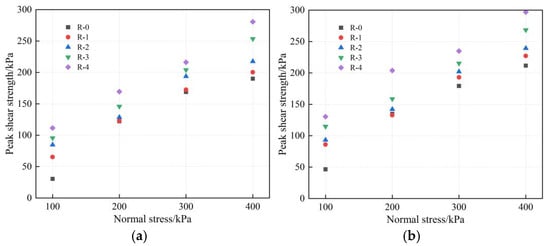
Figure 5.
Curve of shear strength and normal stress relationship: (a) Initial moisture content 14%; (b) Initial moisture content 16%. Note: In this experiment, three parallel tests were carried out in each working condition, and the coefficient of variation of the data was 1.2~3.8%. The repeatability of the test results was good.
Table 4 shows the interface peak shear strength parameters for different levels of interface roughness. It can be seen from the table that as the level of interface roughness increases, the peak cohesion significantly increases, and the peak internal friction angle also shows an increasing trend. The above phenomenon is mainly due to the increase in interface roughness, leading to an increase in the ice bonding force between the soil particles and the concrete, resulting in a sharp increase in peak cohesion.

Table 4.
Interface peak shear strength parameters of different interface roughness levels.
3.3. Residual Shear Strength Characteristics
In this study, 14% and 16% were selected as the initial moisture contents of the soil samples, mainly referring to the natural moisture content distribution characteristics of low-liquid limit clay in the permafrost region of Hoh Xil on the Qinghai–Tibet Plateau (most of the regional measured values are 12~18%). The value is not only in the typical range of the natural water content, but also can reflect the water state of frozen soil in practical engineering. Through the gradient setting of 2%, the influence of differences in the water content on the residual shear strength of the interface can be effectively compared, and it is consistent with the water content control standard of a similar interface test in cold regions. Figure 6 shows the curve of the residual shear strength of the interface as it varies with roughness levels. At all roughness levels, the residual shear strength increases approximately linearly with an increase in normal stress, but the increase is lower compared to the peak shear strength, indicating that the enhancement of residual strength after interface failure mainly relies on the restraining effect of normal stress on the friction between broken ice and soil particles. The residual strength increases with the level of roughness; for example, at an initial moisture content of 14% and a normal stress of 100 kPa, as the roughness level changes from R-0 to R-4, the residual shear strength increases from 25.41 kPa to 70.82 kPa. Comparing Figure 6a,b, it can be seen that the residual strength at an initial moisture content of 16% is generally higher than that at an initial moisture content of 14%, as the higher moisture content provides more recycled ice bonding medium.
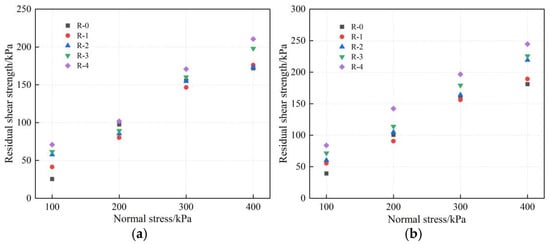
Figure 6.
Curve of residual shear strength varying with roughness grade: (a) Initial moisture content 14%; (b) Initial moisture content 16%. Note: In this experiment, three parallel tests were carried out in each working condition, and the coefficient of variation of the data was 1.2~3.8%. The repeatability of the test results was good.
In the residual strength stage, due to large displacement deformation at the interface, the cementing strength of the interface is almost completely destroyed. Therefore, when calculating the interface strength parameters, it is assumed that the interface cohesion is 0, so at this time, the strength parameters only include the interface friction angle. In order to ensure the reliability of the test results, three parallel tests were carried out under all working conditions. The coefficient of variation of the parallel test data is less than 4%, and the residual friction angle in Table 4 is the statistical result of the three parallel tests. Table 5 shows the residual friction angles at different levels of interface roughness. The residual friction angle is found to increase slightly with the rise in the interface roughness level.

Table 5.
Interface residual shear strength parameters of different interface roughness levels.
4. Conclusions
This article conducts direct shear tests on frozen soil–concrete interfaces, studying the effect of different levels of interface roughness on the shear strength of frozen soil–concrete pile foundations, while also considering the effect of different initial moisture contents. The research results are as follows:
- (1)
- The shear stress–displacement curves of the frozen soil–concrete interface show stress-softening characteristics, which can be divided into three stages: elastic growth, post-peak softening and residual stability. The peak stress appears at the shear displacement of 1–2 mm.
- (2)
- The peak shear strength and ice cementation strength of the interface increase significantly with the roughness grade: when the normal stress is 400 kPa and the water content is 14%, the peak strength of R-4 increases by 47.7% compared with R-0, and the contribution ratio of the ice cementation strength increases with the increase in roughness. The absolute increase in residual strength is smaller but the relative amplitude is larger (178.5% increase under the same working conditions).
- (3)
- The peak and residual shear strength increase linearly with normal stress, and the increase in strength in the high roughness interface (R-4) is slightly larger than that of the low roughness interface (R-0), which is related to the synergistic enhancement of mechanical embedding force and ice cementation force under high roughness.
- (4)
- The response of the strength parameters to roughness is different: the peak cohesion increases significantly with roughness (R-0 to R-4 increases by 268.6%), and the residual cohesion decreases. The peak and residual internal friction angles increase slightly with the roughness (the amplitude is less than 6 °).
The research results have practical guiding significance for cold-region engineering: in the engineering design of building foundations and bridge pile foundations in cold-climate zones, the shear strength of the interface can be enhanced by reasonably increasing the roughness of the frozen soil–concrete interface (such as R-3 and R-4 grades), and the frost heaving damage resistance of the structure can be improved. At the same time, the design needs to combine the normal stress and water content conditions to optimize the interface parameters to ensure the long-term stability of the cold region project.
Author Contributions
Conceptualization, M.X. (Ming Xie), M.X. (Mengqi Xu) and Z.W.; Methodology, L.Y.; Software, X.W.; Validation, F.X. All authors have read and agreed to the published version of the manuscript.
Funding
This research received no external funding.
Data Availability Statement
Data cannot be disclosed due to privacy.
Conflicts of Interest
The authors declare no conflicts of interest.
References
- Ma, W.; Wang, D.Y. Frozen Soil Mechanics; Beijing Science Press: Hangzhou, China, 2014. [Google Scholar]
- Jiang, D.J. Study on Pile-Soil Interface Property and Vertical Bearing Behavior of Pile Foundation in Permafrost. Ph.D. Thesis, Lanzhou Jiaotong University, Lanzhou, China, 2019. [Google Scholar]
- Song, H.F. Study on the Roadbed Structure of Anti-Frost Heave of High-Speed Railway Subgrade in Deep Seasonally Frozen Region. Ph.D. Thesis, Beijing Jiaotong University, Beijing, China, 2020. [Google Scholar]
- Hosseinzadehfard, E.; Mobaraki, B. Corrosion performance and strain behavior of reinforced concrete: Effect of natural pozzolan as partial substitute for microsilica in concrete mixtures. Structures 2025, 79, 109397. [Google Scholar] [CrossRef]
- Mobaraki, B.; Vaghefi, M. The effect of protective barriers on the dynamic response of underground structures. Buildings 2024, 14, 3764. [Google Scholar] [CrossRef]
- Xu, L.L. Creep Characteristics and Constitutive Model of the Contact Surface Between High-Temperature Frozen Soil and Cast-in-Place Concrete. Master’s Thesis, Lanzhou Jiaotong University, Lanzhou, China, 2024. [Google Scholar]
- Dong, X.G.; Lu, J.F.; Li, H.B.; Wang, Z.B. Study on triaxial shear test and mechanical model of contact damage at frozen soil-steel interface. J. Glaciol. Geocryol. 2025, 47, 734–746. [Google Scholar]
- Hu, J.H.; Cui, H.H.; Wang, Y.G.; Li, X.J. Study on the Shear Characteristics of Permafrost-Pile Interface Influenced by Fine Grain Content. Chin. Q. Mech. 2024, 45, 842–854. [Google Scholar]
- Hu, L.M.; Pu, J.L. Experimental study on mechanical characteristics of soil—structure interface. Chin. J. Geotech. Eng. 2001, 4, 431–435. [Google Scholar]
- Wang, Y.H.; Zhang, M.Y.; Liu, J.W.; Bai, X.Y. Effect of Interface Roughness on Interfacial Shear Properties of Clayey Soil-Concrete. Ind. Constr. 2017, 47, 93–97. [Google Scholar]
- He, F.; Lei, W.Y.; Mao, E.Q.; Liu, Q.Q.; Chen, H.J.; Wang, X. Creep constitutive modeling of the shear strength of the permafrost-concrete interface considering the stress level at −1 °C. PLoS ONE 2024, 19, e0297824. [Google Scholar] [CrossRef] [PubMed]
- Maria, J.R.; Eduardo, C.; Costa, L.N.; Eduardo, J. A novel roughness parameter for more precise estimation of the shear strength of concrete-to-concrete interfaces. Constr. Build. Mater. 2024, 410, 134146. [Google Scholar]
- Fang, R.C.; Wang, B.X.; Pan, J.J.; Liu, J.Q.; Wang, Z.H.; Wang, Q.; Ling, X.Z. Effect of concrete surface roughness on shear strength of frozen soil–concrete interface based on 3D printing technology. Constr. Build. Mater. 2023, 366, 130158. [Google Scholar] [CrossRef]
- Wang, X.; Cheng, H.; Yan, P.; Zhang, J.S.; Ding, Y. The influence of roughness on cyclic and post-cyclic shear behavior of red clay-concrete interface subjected to up to 1000 cycles. Constr. Build. Mater. 2020, 273, 121718. [Google Scholar] [CrossRef]
- Yuan, S.B.; Cong, J.M.; Fang, X.G.; Wu, Y.; Yu, H.C. Experimental study on the shear characteristics of frozen soil-concrete interface under the constant normal stiffness. Eng. Rep. 2024, 6, e12989. [Google Scholar] [CrossRef]
- Wuan, X.S.; Zhou, H.; Lu, J.G.; Yan, Z.R.; Liu, F.Y.; Yang, Q.C. Experimental Study on Shear Characteristics of Saline Frozen Soil-Concrete Interface. J. Eng. Geol. 2025. early access. [Google Scholar]
- Wang, R. Experimental Study on the Shear Characteristics of the Plateau Frozen Soil-Structure Interface and Discussion on Damage Constitutive Relationship. Cold Reg. Sci. Technol. 2023, 206, 103739. [Google Scholar]
- Ji, Y.J.; Jia, K.; Yu, Q.H.; Jin, H.J.; Guo, L.; Luo, X.X. Direct shear tests of freezing strength at the interface between cast-in-situ concrete and frozen soil. J. Glaciol. Geocryol. 2017, 39, 86–91. [Google Scholar]
- Zhao, L.Z.; Yang, P.; Wang, H.B. Development and application of large-scale multi-functional frozensoil-structure interface cycle-shearing system. Chin. J. Geotech. Eng. 2013, 35, 707–713. [Google Scholar]
- Wan, X.S.; Zhou, H.; Zhou, F.X.; Zhu, J.S. Mesoscopic shear evolution characteristics of frozen soil-concrete interface. Cold Reg. Sci. Technol. 2025, 229, 104342. [Google Scholar] [CrossRef]
- Zhang, K.; Yan, J.L.; Mu, Y.H.; Zhu, X.M.; Zhang, L.H. Global and Local Shear Behavior of the Frozen Soil–Concrete Interface: Effects of Temperature, Water Content, Normal Stress, and Shear Rate. Buildings 2024, 14, 3319. [Google Scholar] [CrossRef]
- Zhou, J.; Ban, C.; Liu, C.; Zhou, H. Study on the shear characteristics of the cemented soil-concrete interface after artificial freeze-thaw under vibration loading. IOP Conf. Ser. Earth Environ. Sci. 2024, 1333, 012024. [Google Scholar] [CrossRef]
- Wang, B.X.; Gao, Y.L.; Wang, Q.; Liu, J.Q. Effect of Freeze-Thaw Cycles on Shear Properties of Seasonal Frozen Soil Area Silty Clay-Concrete Interface. J. Jilin Univ. (Earth Sci. Ed.) 2024, 54, 1592–1603. [Google Scholar]
- Zhou, Y.L.; Wang, X.; Jiang, D.J.; Liu, D.R.; He, F.; Hu, Y.; Liu, P. Shear behavior of pile-soil interface considering ice film thickness and frostjacking calculation of piles in frozen soil regions. Chin. J. Rock Mech. Eng. 2023, 42, 2806–2819. [Google Scholar]
- GB/T 50123-2019; Soil Test Method Standard. China Plan Press: Beijing, China, 2019.
- GB/T 50081-2002; Standard for Test Method of Mechanical Mechanical Properties on Ordinary Concrete. Construction Ministry of PRC: Beijing, China, 2002.
Disclaimer/Publisher’s Note: The statements, opinions and data contained in all publications are solely those of the individual author(s) and contributor(s) and not of MDPI and/or the editor(s). MDPI and/or the editor(s) disclaim responsibility for any injury to people or property resulting from any ideas, methods, instructions or products referred to in the content. |
© 2025 by the authors. Licensee MDPI, Basel, Switzerland. This article is an open access article distributed under the terms and conditions of the Creative Commons Attribution (CC BY) license (https://creativecommons.org/licenses/by/4.0/).